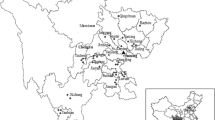Summary
Physiological and symbiotic characteristics were identified in fast-growing (FG)Rhizobium japonicum. Carbon nutritional patterns linked these rhizobia to other FG rhizobia. They were able to use hexoses, pentoses, disaccharides, trioses, and organic acids for growth, but they were unable to use dulcitol or citrate. These rhizobia produced acid with all carbon sources except intermediates of the Krebs cycle. FGR. japonicum showed no vitamin requirements and were tolerant to 1% NaCl but not to 2%. They nodulated cowpea, pigeon pea, and mung bean but not peanut. Effective, nitrogen-fixing symbioses were observed only with cowpea and pigeon pea. In addition, FGR. japonicum formed effective symbioses with Asian-type soybeans. We concluded that although the physiological characteristics of FGR. japonicum were similar to other FG rhizobia, their symbiotic properties were similar to slow-growing rhizobia of the cowpea miscellany.
Similar content being viewed by others
References
Ahmad M H, Eaglesham A R J, Hassouna S, Seaman B, Ayanaba A, Mulongoy K and Pulver E L 1981 Examining the potential for inoculant use with cowpeas in West African Soils. Trop. Agric. (Trinidad) 58, 325–335.
Ahmad M H, Eaglesham A R J and Hassouna S 1981 Examining serological diversity of cowpea rhizobia by the ELISA technique. Arch. Microbiol. 130, 281–287.
Bradford M M 1976 A rapid and sensitive method for the quantitation of microgram quantities of protein utilizing the principle of protein-dye binding. Anal. Biochem. 72, 248–254.
Bromfield E S P and Roughley R J 1980 Characterization of rhizobia isolated from nodules on locally-adaptedGlycine max grown in Nigeria. Ann. Appl. Biol. 95, 185–190.
Cole M A and Elkan G H 1979 Multiple antibiotic resistance inRhizobium japonicum. Appl. Environ. Microbiol. 37, 867–870.
Eaglesham A R J, Hassouna S and Seegers R 1983 Fertilizer-N effects on N2 fixation by cowpea and soybean. Agron. J. 75, 61–66.
Graham P H 1964 Studies on the utilization of carbohydrates and Krebs cycle intermediates by rhizobia, using an agar plate method. Antonie van Leeuwenhoek J. Microbiol. Serol. 30
Graham P H and Parker C A 1964 Diagnostic features in the characterization of the root-nodule bacteria of legumes. Plant and Soil 20, 383–396.
Hooykaas P J J, van Brussel A A N, den Dulk-Ras H, van Slogteren G M S and Schilperoort R A 1981 Sym plasmid ofR. trifolii expressed in different rhizobial species andAgrobacterium tumefaciens. Nature London 291, 351–353.
Jordan D C and Allen O N 1974 Rhizobiaceae.In Bergey's Manual of Determinative Bacteriology, 8th edition, pp 261–267. Eds R E Buchanan and N E Gibbons, The Williams and Wilkins Company, Baltimore.
Jordan D C 1982 Transfer ofRhizobium japonicum Buchanan 1980 toBradyrhizobium gen. nov., a genus of slow-growing, root nodule bacteria from leguminous plants. Int. J. Syst. Bacteriol. 32, 136–139.
Josey D P, Beynon J L, Johnston A W B and Beringer J E 1979 Strain identification in Rhizobium using intrinsic antibiotic resistance. J. Appl. Bacteriol. 46, 343–350.
Keele B B, Hamilton P B and Elkan G H 1969 Glucose catabolism inRhizobium japonicum. J. Bacteriol. 97, 1184–1191.
Keyser H H, Bohlool B B, Hu T S and Weber D F 1982 Fast-growing rhizobia isolated from root nodules of soybean. Science 215, 1631–1632.
Martinez-De Drets G and Arias A 1972 Enzymatic basis for differentiation ofRhizobium into fast- and slow-growing groups. J. Bacteriol. 109, 467–470.
Masterson R V, Russell P R and Atherly A G 1982 Nitrogen fixation (nif) genes and large plasmids ofRhizobium japonicum. J. Bacteriol. 152, 928–931.
Norris D O and Date R A 1976 Legume bacteriology.In Tropical Pasture Research: Principles and Methods, pp 134–174. Eds N H Shaw and W W Bryan, Bulletin 51, Commonwealth Agricultural Bureau, Canberra.
Pulver E L, Brockman F and Wien H C 1982 Nodulation of soybean cultivars withRhizobium spp. and their response to inoculation withR. japonicum. Crop Sci. 22, 1065–1070.
Ranga Rao V, Ayanaba A, Eaglesham A R J and Kueneman E A 1981 Exploiting symbiotic nitrogen fixation for increasing soybean yields in Africa.In Global Impacts of Applied Microbiology VI, pp 153–167. Eds S O Emejuaiwe, O Ogunbi, and S O Sanni, Academic Press, London.
Russell P F and Atherly A G 1982 Plasmids inRhizobium japonicum.In Proceedings of the Eighth North AmericanRhizobium Conference, pp 55–66. Eds K Clark and J H G Stevens, Manitoba Univ. Press, Winnipeg.
Stowers M D and Elkan G H 1983 The transport and metabolism of glucose by cowpea rhizobia. Can. J. Microbiol. 29, 398–406.
Vincent J M 1970 A Manual for the Practical Study of Root-nodule Bacteria. International Biological Programme, Blackwell Scientific Publications, Oxford, 164 p.
Yelton M M, Yang S S, Edie S A and Lim S T 1983 Characterization of an effective salt-tolerant, fast-growing strain ofRhizobium japonicum. J. Gen. Microbiol. 129, 1537–1547.
Author information
Authors and Affiliations
Rights and permissions
About this article
Cite this article
Stowers, M.D., Eaglesham, A.R.J. Physiological and symbiotic characteristics of fast-growingRhizobium japonicum . Plant Soil 77, 3–14 (1984). https://doi.org/10.1007/BF02182807
Received:
Revised:
Issue Date:
DOI: https://doi.org/10.1007/BF02182807




